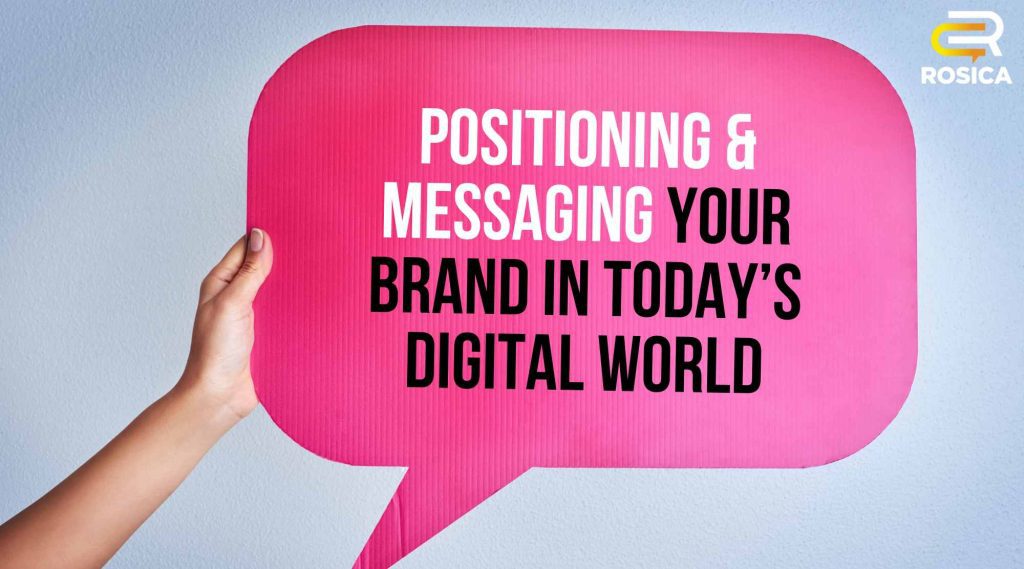In today’s hyper-saturated digital landscape, brands—both nonprofit and for-profit—are no longer just competing on product or service offerings. They’re vying for attention, connection, and trust through what we call the “3Vs” – voice, values, and visibility. As the online universe continues to expand, it’s becoming harder for organizations to cut through the noise. That’s where strategic brand positioning and messaging come into play.
At the heart of a successful communications strategy is the ability to articulate not just what you do, but why you do it—what moves you, what defines you, why stakeholders should care, and what differentiates your organization. Whether you’re a school district, healthcare system, nonprofit, or purpose-driven brand, the way you show up and speak across various platforms has never mattered more.
As a multi-award winning, national PR firm with decades of experience in positioning and messaging, Rosica Communications knows what it takes to break through. In this article, we explore how leading organizations are using compelling narratives, clear messaging, and professional communications strategies to remain relevant, drive thought leadership, and protect their reputations.
Differentiate Through a Clear & Compelling Value Proposition
One of the most common mistakes we see is brands leading with products, services, features, and benefits that other organizations position similarly. Simply saying what you do is not enough—you need to convey how you’re different and why that matters. Consider this: a nonprofit that states, “We support students’ academic success,” versus “We help first-generation higher-ed students get into—and graduate from—college, with ongoing mentorship for life.” This communicates a purpose, a process, and a promise.
Leading with emotion, then backing it up with logic and proof points, is a powerful formula. This approach creates resonance and trust—especially in sectors like healthcare, education, and nonprofits where personal impact and mission alignment matter deeply.
Cleveland Clinic is a great example of this strategy in action. Rather than simply positioning itself as a world-class hospital, it focuses on human-centered care. Its tagline, “Every Life Deserves World Class Care,” is inclusive, emotionally resonant, and reflective of its broader mission. It appeals not only to the intellect, but to the heart.
As a thought leadership PR partner, our team helps mission-driven organizations uncover and articulate this unique value—shaping language that evokes their missions, builds trust, and differentiates them in crowded industry sectors.
Maintain Consistent Messaging Across All Platforms
Even the most powerful message falls flat if it’s not delivered consistently. When a brand’s tone is compassionate on its website, quirky on Instagram, and professional in email communications, it can create confusion about the brand’s voice.
Take the Mayo Clinic. Every message, whether in a blog post, YouTube video, or social caption, maintains the same tone: authoritative, calming, and patient-first. This consistency is no accident—it stems from an intentional brand strategy that includes internal messaging guides, staff training, and ongoing review.
This is especially critical for organizations with multiple departments and communications channels. Everyone, from leadership to social media interns, needs to be aligned. As a social media agency with a concentration in healthcare PR, we routinely develop messaging guides that help our clients speak with one voice across touchpoints—ensuring their stakeholders know what they stand for and why it’s important, which must be logical and intuitive.
Be Prepared During Crises
In the digital age, reputation management is no longer a reactive task, but a constant, proactive necessity. Crises happen and can take many forms in today’s society. They arrive suddenly, and how you respond can either fortify or damage your organization’s credibility and good standing.
During the COVID-19 pandemic, healthcare institutions had to communicate faster and more transparently than ever. Messaging had to be accurate, compassionate, inclusive, and adaptable. Organizations that were prepared—with clear chains of communication, trained spokespeople, and ready-to-go messaging—were better positioned to lead with calm and clarity. But not many organizations were prepared despite data showing new, rogue viruses are capable of spreading fast—and globally.
Crisis communication agencies prepare nonprofits and for-profits long before a crisis occurs. They guide them in crafting messaging frameworks, building internal response teams, and ensuring legal, HR, and communications departments are aligned and communicating complementary messages. When a crisis emerges, these organizations and government entities must act swiftly—crafting strategic, empathetic messaging to promote trust and confidence.
A strong value proposition may earn attention, but smart crisis communications earns brand loyalty.
Stay Culturally Relevant
Cultural relevance can be a powerful way to boost visibility, particularly when communicating with varying demographics and in the world of online and social media. National awareness months, social challenges, and breaking news cycles can offer organizations opportunities to align with conversations that matter to their audiences; however, these alone are not enough.
Nonprofits and mission-driven organizations should participate in cultural moments only when there’s a real, authentic connection to their mission. Jumping on a trending hashtag without substance can backfire—appearing opportunistic or off-brand.
A disaster relief organization, for instance, might use National Preparedness Month to share useful tips and stories that tie directly into its mission. That’s smart, mission-aligned relevance. But if the same group tries to capitalize on a pop culture event tangentially related to the cause, this may dilute the critical relevance of its work.
Partnering with a nonprofit PR firm like Rosica, that advises clients to think critically about their digital presence, can help. Is a particular platform or trend relevant? Does it serve your mission? Is your participation genuine? Cultural relevance should enhance credibility—not compromise it.
Conclusion
In an environment where every click, scroll, video, and post competes for attention, brands must go beyond visibility. They need clarity, consistency, and adaptability.
Whether you’re a nonprofit seeking donors, a school communicating with parents, or a healthcare system aiming to build trust and loyalty, the way you position and communicate your brand is essential. Strong positioning isn’t just about marketing—it’s about differentiation at the level of leadership, perception, and impact.
About Rosica Communications
At Rosica, we’re proud to be leaders in thought leadership. We’re more than just a national PR firm—we’re partners in shaping powerful narratives, solving communication challenges, and building reputations that truly resonate. From branding and crisis response to content development and digital strategy, our team works for mission entities. As trusted crisis communications and social media strategy experts, we aim to help our clients stand out, stay relevant, and achieve their communications and organizational goals.
To learn more, schedule a call with Chris, President and CEO of Rosica, via the following link: https://calendly.com/rosica/30min.
We can’t wait to hear about your organization’s strategic imperatives!

